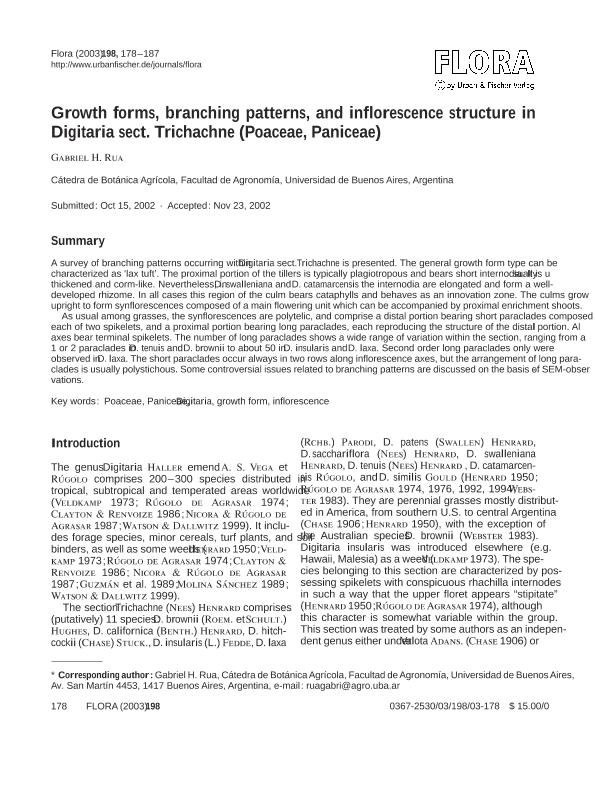Artículo
Growth forms, branching patterns, and inflorescence structure in Digitaria sect. Trichachne (Poaceae, Paniceae)
Fecha de publicación:
12/2003
Editorial:
Elsevier Gmbh
Revista:
Flora
ISSN:
0367-2530
Idioma:
Inglés
Tipo de recurso:
Artículo publicado
Clasificación temática:
Resumen
A survey of branching patterns occurring within Digitaria sect. Trichachne is presented. The general growth form type can be characterized as 'lax tuft'. The proximal portion of the tillers is typically plagiotropous and bears short internodia. It is usually thickened and corm-like. Nevertheless, in D. swalleniana and D. catamarcensis the internodia are elongated and form a well-developed rhizome. In all cases this region of the culm bears cataphylls and behaves as an innovation zone. The culms grow upright to form synflorescences composed of a main flowering unit which can be accompanied by proximal enrichment shoots. As usual among grasses, the synflorescences are polytelic, and comprise a distal portion bearing short paraclades composed each of two spikelets, and a proximal portion bearing long paraclades, each reproducing the structure of the distal portion. All axes bear terminal spikelets. The number of long paraclades shows a wide range of variation within the section, ranging from a 1 or 2 paraclades in D. tenuis and D. brownii to about 50 in D. insularis and D. laxa. Second order long paraclades only were observed in D. laxa. The short paraclades occur always in two rows along inflorescence axes, but the arrangement of long paraclades is usually polystichous. Some controversial issues related to branching patterns are discussed on the basis of SEM-observations.
Palabras clave:
DIGITARIA
,
GROWTH FORM
,
INFLORESCENCE
,
PANICEAE
,
POACEAE
Archivos asociados
Licencia
Identificadores
Colecciones
Articulos(OCA PQUE. CENTENARIO)
Articulos de OFICINA DE COORDINACION ADMINISTRATIVA PQUE. CENTENARIO
Articulos de OFICINA DE COORDINACION ADMINISTRATIVA PQUE. CENTENARIO
Citación
Rua, Gabriel Hugo; Growth forms, branching patterns, and inflorescence structure in Digitaria sect. Trichachne (Poaceae, Paniceae); Elsevier Gmbh; Flora; 198; 3; 12-2003; 178-187
Compartir
Altmétricas




